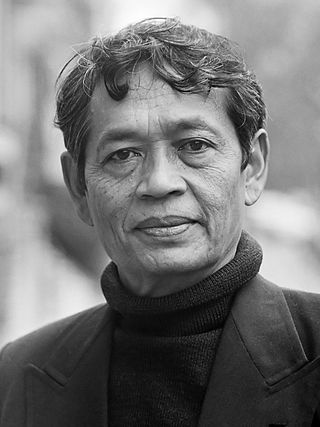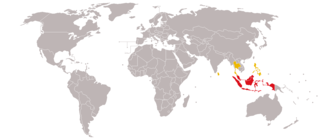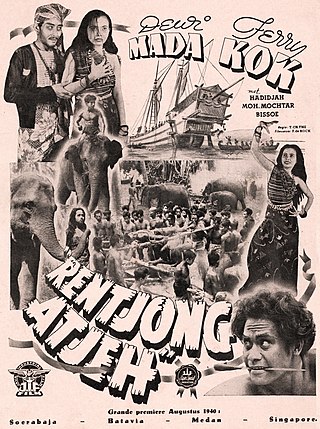Related Research Articles

Aceh, officially the Province of Aceh, is the westernmost province of Indonesia. It is located on the northern end of Sumatra island, with Banda Aceh being its capital and largest city. It is bordered by the Indian Ocean to the west, Strait of Malacca to the northeast, as well bordering the province of North Sumatra to the east, and shares maritime borders with Malaysia and Thailand to the east, and Andaman and Nicobar Islands of India to the north. Granted a special autonomous status, Aceh is a religiously conservative territory and the only Indonesian province practicing Sharia law officially. There are ten indigenous ethnic groups in this region, the largest being the Acehnese people, accounting for approximately 70% of the region's population of about 5.4 million people in mid 2022.

The Aceh War, also known as the Dutch War or the Infidel War (1873–1904), was an armed military conflict between the Sultanate of Aceh and the Kingdom of the Netherlands which was triggered by discussions between representatives of Aceh and the United States in Singapore during early 1873. The war was part of a series of conflicts in the late 19th century that consolidated Dutch rule over modern-day Indonesia.
Juramentado, in Philippine history, refers to a male Moro swordsman who attacked and killed targeted occupying and invading police and soldiers, expecting to be killed himself, the martyrdom undertaken as a form of jihad, considered a form of suicide attack. Unlike an amok, who commits acts of random violence against Muslims and non-Muslims alike, a juramentado was a dedicated, premeditated, and sometimes highly skilled killer who prepared himself through a ritual of binding, shaving, and prayer in order to accomplish brazen attacks armed only with edged weapons.

The term Proto-Malay, primeval Malays, proto-Hesperonesians, first-wave Hesperonesians or primeval Hesperonesians, which translates to Melayu Asli or Melayu Purba or Melayu Tua, refers to Austronesian speakers who moved from mainland Asia, to the Malay peninsula and Malay archipelago in a long series of migrations between 2500 and 1500 BC, before that of the Deutero-Malays about a thousand years later. The Proto-Malays are descendants of the first humans living in Southeast Asia, and are "ancestral" for humans in east Asia and the Americas.

The Sultanate of Aceh, officially the Kingdom of Aceh Darussalam, was a sultanate centered in the modern-day Indonesian province of Aceh. It was a major regional power in the 16th and 17th centuries, before experiencing a long period of decline. Its capital was Kutaraja, the present-day Banda Aceh.

Iskandar Muda was the twelfth Sultan of Acèh Darussalam, under whom the sultanate achieved its greatest territorial extent, holding sway as the strongest power and wealthiest state in the western Indonesian archipelago and the Strait of Malacca. "Iskandar Muda" literally means "young Alexander," and his conquests were often compared to those of Alexander the Great. In addition to his notable conquests, during his reign, Aceh became known as an international centre of Islamic learning and trade. He was the last Sultan of Aceh who was a direct lineal male descendant of Ali Mughayat Syah, the founder of the Aceh Sultanate. Iskandar Muda's death meant that the founding dynasty of the Aceh Sultanate, the House of Meukuta Alam died out and was replaced by another dynasty.

Teungku Mohammad Daud Beureueh was the military Governor of Aceh (1945–1953) and leader of the Darul Islam rebellion in the province (1953–1963).

Bima is a city on the eastern coast of the island of Sumbawa in central Indonesia's province of West Nusa Tenggara. It is the largest city on the island of Sumbawa, with a population of 142,443 at the 2010 census and 155,140 at the 2020 census; the official estimate as at mid-2022 was 157,362. It is separate from the adjoining Regency of Bima which had a population of 520,444 according to the mid-2021 official estimates.

Mochtar Lubis was an Indonesian Batak journalist and novelist who co-founded Indonesia Raya and monthly literary magazine "Horison". His novel Senja di Jakarta was the first Indonesian novel to be translated into English. He was a critic of Sukarno and was imprisoned by him.
Stuart Herriot was a British-born trader based in Penang.

The Acehnese are an indigenous ethnic group from Aceh, Indonesia on the northernmost tip of the island of Sumatra. The area has a history of political struggle against the Dutch colonial rule. The vast majority of the Acehnese people are Muslims. The Acehnese people are also referred to by other names such as Lam Muri, Lambri, Akhir, Achin, Asji, A-tse and Atse. Their language, Acehnese, belongs to the Aceh–Chamic group of Malayo-Polynesian of the Austronesian language family.
Minangkabau businesspeople refers to merchants from the Minangkabau Highlands in central Sumatra, Indonesia. Minangkabau are the ethnic majority in West Sumatra and Negeri Sembilan. Minangkabau are also a recognised minority in other parts of Indonesia as well as Malaysia, Singapore and the Netherlands.

The Malay world or Malay realm is a concept or an expression that has been used by different authors and groups over time to denote several different notions, derived from varied interpretations of 'Malay' either as an ethnic group, as a racial category, as a linguistic group or as a cultural group. The use of the term Malay in much of the conceptualisation is largely based on the prevalent Malay cultural influence, manifested in particular through the spread of the Malay language in Southeast Asia as observed by different colonial powers during the Age of Discovery and spread of Islam. The term remains highly controversial in Indonesia and outside the Malay-speaking areas, because it is considered politically charged and irredentist rather than purely cultural.

Rentjong Atjeh is a 1940 action film from the Dutch East Indies directed by The Teng Chun. Telling of a group who take revenge against pirates in the Strait of Malacca, it starred Ferry Kock, Dewi Mada, Bissoe, Mohammad Mochtar, and Hadidjah. It was filmed near the shore in Batavia and reused footage from The's earlier work Alang-Alang (1939). Rentjong Atjeh, inspired in part by the Tarzan films, was a commercial success, although it may now be lost.

The military history of Indonesia includes the military history of the modern nation of Republic of Indonesia, as well as the military history of the states which preceded and formed it. It encompassed a kaleidoscope of conflicts spanning over a millennia. The ancient and medieval part of it began as tribal warfare began among indigenous populations, and escalated as kingdoms emerged. The modern part is defined by foreign colonial occupations, battles for independence through guerrilla warfare during Indonesian National Revolution, regional conquests and disputes with neighbouring countries, as well as battles between the Republic and separatist factions. Since the formation of the Republic, the military has played significant role in state affairs. However, in Post-Suharto era, the Indonesian military has retreated from politics, yet it still possesses some influences.

Ghurab or gurab is a type of merchant and warship from the Nusantara archipelago. The ship was a result of Mediterranean influences in the region, particularly introduced by the Arabs, Persians, and Ottomans. For their war fleet, the Malays prefer to use shallow draught, oared longships similar to the galley, such as lancaran, penjajap, and kelulus. This is very different from the Javanese who prefer long-range, deep-draught round ships such as jong and malangbang. The reason for this difference is that the Malays operated their ships in riverine water, sheltered straits zone, and archipelagic environment, while the Javanese are often active in the open and high sea. After contact with Iberian people, both the Javanese and Malay fleets began to use the ghurab and ghali more frequently.

Pewarta Deli was a Malay language newspaper published in Medan, Dutch East Indies from 1910 until 1941, and again from 1945–6. During its run the paper became a strident anti-colonial voice, sympathetic to the Sarekat Islam and Indonesian nationalism and critical of the cruelty of big business in Medan's tobacco and plantation industries. It also gave space in its pages to Communism and Islamic modernism. The paper had a wide readership in its time, with an influence not only in the Indies, but also among Malays in British Malaya.

The Gouvernment of Atjeh and Dependencies was an administrative subdivision (governorate) of the Dutch East Indies located in northern Sumatra in the region of present-day Aceh, Indonesia which existed from the late nineteenth century to 1938. The capital of the governorate was at Koetaradja. In 1938, due to a reorganization of the government structure of the Indies, it no longer had a governor and became a Residency instead, called the Atjeh and Dependencies Residency.
John Norman Miksic is an American-born archaeologist.

Abdoel Firman Siregar gelar Mangaradja Soangkoepon was a politician and Volksraad member in the Dutch East Indies. He was an Indonesian nationalist and was a political ally of many of the leaders who came to power in the early independence era, although he himself died before the country achieved its independence.
References
- ↑ Reid, Anthony (1969), The contest for North Sumatra : Atjeh, the Netherlands and Britain, 1858-1898, O.U.P, ISBN 978-0-19-638091-9
- ↑ Reid, Anthony; Penerbit Universiti Malaya, (publisher.) (2017), The contest for North Sumatra : Aceh, the Netherlands and Britain, 1858-1898 (2 ed.), University of Malaya Press, ISBN 978-983-100-884-3
- ↑ Reid, Anthony; Maris, Masri (2007), Asal mula konflik Aceh : dari perebutan Pantai Timur Sumatera hingga akhir Kerajaan Aceh abad ke 19 (2 ed.), Jakarta Yayasan Obor Indonesia, ISBN 978-979-461-534-8